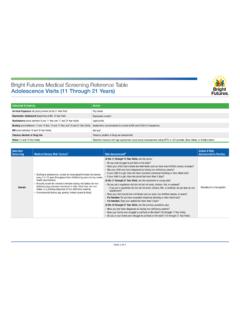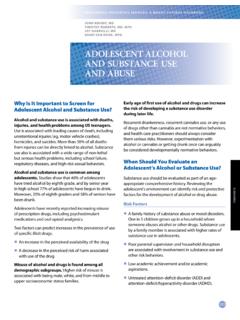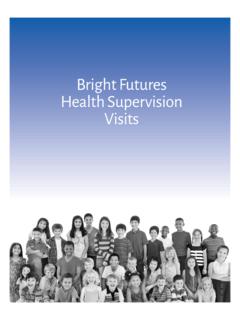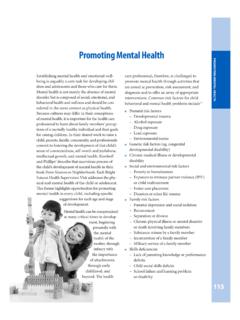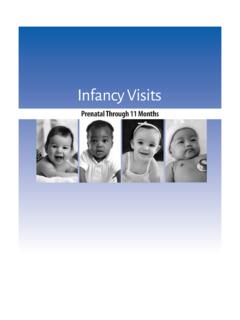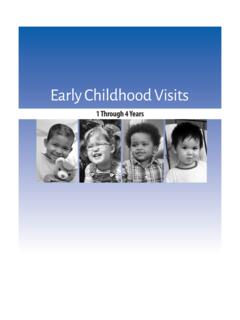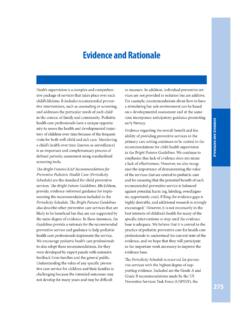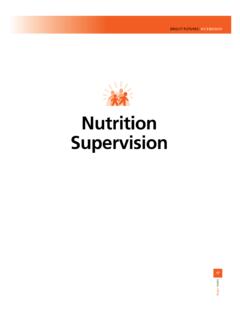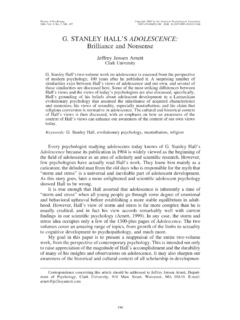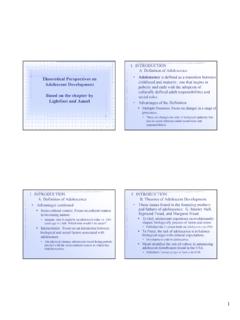Transcription of Adolescence Visits - Bright Futures
1 11 Through 21 YearsAdolescence VisitsBFG 4TH 7311/20/17 2:48 PM733 EARLY ADOLESCENCE11 THROUGH 14 YEAR VISITSE arly Adolescence11 Through 14 Year VisitsContextThe early adolescent is embarking on a journey of remarkable transitions and transformations physically, cognitively, emotionally, and socially and the pace at which he experiences these physical and emotional changes varies widely. The onset of puberty is one indicator that the adoles-cent phase of life is beginning. Puberty typically manifests itself visibly with breast development at about age 9 or 10 years for girls, and testicular enlargement for boys at about age 11 years. Many youth have some degree of pubertal developmental as they enter early Adolescence . Breast develop-ment occurs about 1 year earlier in girls of normal weight who are non-Hispanic African American or Mexican American than it does in girls of nor-mal weight who are non-Hispanic These changes are accompanied by a growth spurt.
2 For girls, the maximal growth rate is reached about 6 to 12 months before menarche. Boys have a later growth spurt and, during their growth spurt, have a greater peak height velocity1 than girls. Other physical changes also become apparent. The skin of both boys and girls becomes oily as apocrine glands begin to secrete. Secondary sex character-istics (ie, female breasts, characteristics of male genitalia, and pubic hair) develop, notable changes in body fat and musculature occur, and a boy s voice begins to change. Many of these physical changes are more closely associated with the stage of sexual maturity than with chronological age. The average age for menarche is between 12 and 13 years. The American Academy of Pediatrics (AAP) and the American College of Obstetricians and Gynecologists recommend that health care professionals view the menstrual cycle as a vital s i g n 2 and include education about the normal timing and characteristics of menstruation and other pubertal markers as an important compo-nent of health supervision for young girls and their parents.
3 Puberty, perhaps the key developmental milestone of early Adolescence , is an important focus for all cultures. Health care professionals should seek to understand the meaning of it in the cultures of the families they serve. Early adolescents with special health care needs can experience puberty at the usual time or they can have an earlier or delayed onset of pubertal change based on their health condition. All chil-dren should receive appropriate education about the changes of puberty and what to expect for themselves and Recent studies have shown that the age of onset of puberty is decreas-ing in both girls and These changes have implications both medically, in determining who requires evaluation for premature puberty, and socially, as some adolescents, especially girls, may have difficulties because of a mismatch between their physical appearance, chronological age, and psychological with the physical changes of puberty, the early adolescent s cognitive abilities are devel-oping.
4 As he matures, he develops an increased capacity for logical, abstract, and idealistic think-ing. Schooling shifts from the emotionally secure BFG 4TH 7331/20/17 2:48 PMBright Futures Guidelines for Health Supervision of Infants, Children, and Adolescents734 EARLY ADOLESCENCE11 THROUGH 14 YEAR Visits environment of elementary school, where students have only a single teacher and the same classmates, to the more challenging social environment of middle school and high school, with intense course work, multiple teachers, multiple groups of class-mates, and rising expectations for academic and social advancement. These academic demands provide many opportunities for the early adoles-cent to explore his burgeoning interests and for his sense of achievement and self-esteem to blossom.
5 They also can unmask a previously undiagnosed learning disorder or attention-deficit problems, or can affect the adolescent s ability to cope, which, in turn, can lead to depression and other mental health issues. As academic work increases in com-plexity, parents may feel challenged and unsure about how to help. These issues can be even more difficult for the youth with special health care needs, who may be challenged physically, cog-nitively, or socially to engage in school activities and fit in with his peers. Socially, the early adolescent experiences dramatic changes over relatively few years as he matures. He needs to belong to a peer group and he desires the independence or freedom to do what he wants and with whom he wants.
6 However, these changes do not occur at the same time or at the same pace among all youth. In an attempt to keep pace with individual physical changes that can outpace or lag behind that of his friends, a young adolescent often will use clothing (eg, designer T-shirts), accessories (eg, body piercing or tattoos), and hairstyles (eg, color rinses) as a way to fit in with peers. The youth with special health care needs experiences the same social changes, although his reactions may be influenced by the nature of his condition and the level of acceptance of his condi-tion by friends, family, and community (eg, stigma of being human immunodeficiency virus positive or having a very obvious physical difference).For many, early Adolescence can be a difficult time socially.
7 Parents and educators must remain alert and take extra steps to ensure inclusion as social networks form and re-form, and activities sometimes take place in geographically dispersed parts of the community. The age at which an ado-lescent can obtain a driver s license varies from state to state, so he may have to walk, ride his bike, use public transportation, or depend upon others, including other friends, to drive him to such popular hangouts as shopping malls, movie theatres, music concerts, and parks. Parental monitoring remains critical to ensure that young adolescents remain safe while gradually becoming more independent. As the early adolescent matures, he spends time without adult supervision both at home and away. This freedom presents opportunities to mature in new responsibilities and develop strong decision-making skills.
8 Indeed, many early ado-lescents begin babysitting other children, includ-ing their younger siblings. This new freedom presents challenges because of the attractions of risky behaviors. The temptation to experience something that one believes is pleasurable or cool or that builds status is hard to resist if the youth lacks insight to the consequences, has poor negotiation skills, and has ample opportunity to experiment. Brain research demonstrates that the neurologic structures that underlie the functions of controlling impulses and making decisions are still maturing during Discretion and decision-making is further inhibited under the influence of alcohol or drugs. As a social creature, the adolescent enjoys being with his friends, hav-ing fun, and going places.
9 Shored up by the power and energy of his peer group, the early adolescent may shun caution to satisfy his curiosity. If he is eager to impress a new friend or a crush, a naive, uninitiated youth may feel overly confident about engaging in risky behavior. The introduction and proliferation of new social media technologies have made the social interactions of early Adolescence more complicated than in previous generations, BFG 4TH 7341/20/17 2:48 PMBright Futures Guidelines for Health Supervision of Infants, Children, and Adolescents735 EARLY ADOLESCENCE11 THROUGH 14 YEAR Visits with issues such as lack of privacy, bullying, and sexting adding layers of complexity and difficulty to the daily life of the young adolescent s relationships with his parents and other adults may begin to change during the early stages of this period.
10 In some families, an orderly progression to independent decision-making can be noted. For many young people, however, mood swings and attempts at independence can trigger volatile arguments and challenges to rules. Occasional arguments with parents are common. Authoritative (accepting, firm, and democratic) parents who have a balanced approach with unconditional love combined with clear bound-aries (family rules, limits, and expectations) and consistent enforcement of discipline build a strong protective bond between themselves and their adolescent. Research data consistently show that authoritative parents have adolescents who are less depressed, enter into risk-taking behaviors at later ages, and succeed better academically than parents who use authoritarian (strong parental control with low warmth and little youth input) Having a positive relationship with parents, engagement in school and community activities, and a sense of spirituality are major assets associated with positive youth (For more information on this topic, see the Promoting Lifelong Health for Families and Communities, Promoting Healthy Development, and Promoting Family Support themes.)
